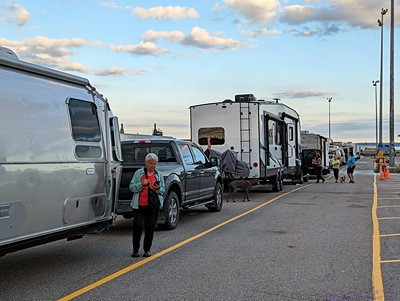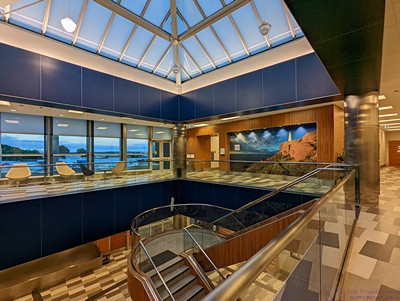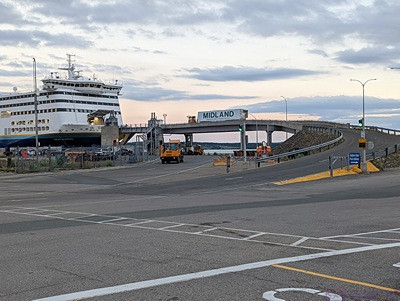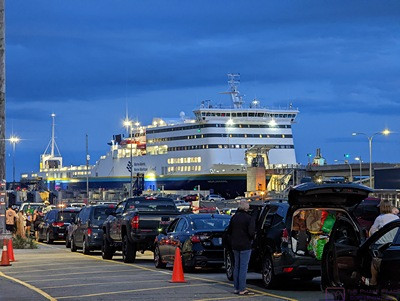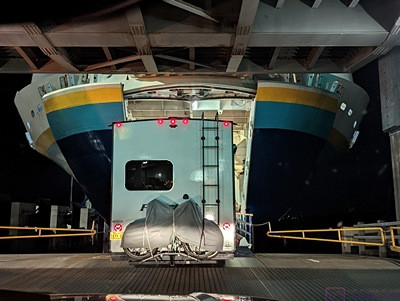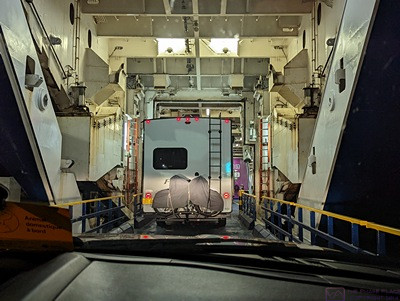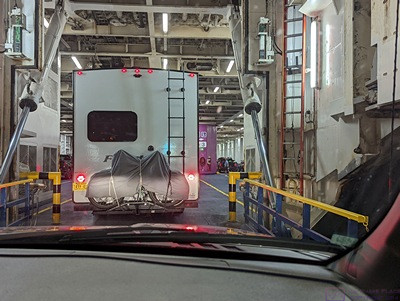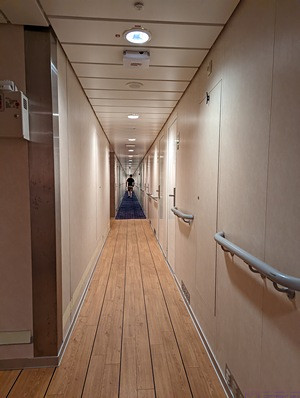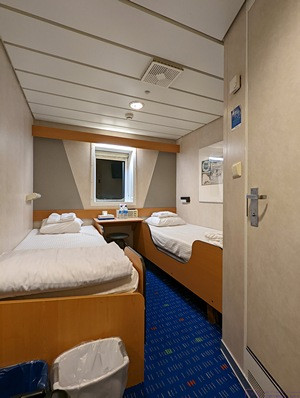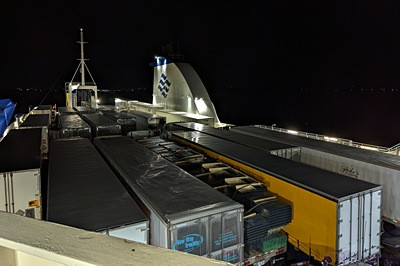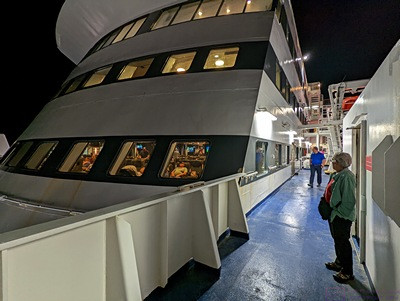THURSDAY 28 July into FRIDAY 29 July
(Note: The photos are mostly in chronological order, but do not necessarily correspond to the adjacent text. Captions matter.)
We started our final travel preparations at 7 PM and pulled out of the KOA at 7:30 in order to arrive at the ferry terminal a bit early and while there was still daylight. Also, if you have not checked in by 2 hours prior to scheduled departure they cancel your booking and assign it to stand-by vehicles.
The Marine Atlantic Terminal in North Sydney, Nova Scotia has its own exit from Hwy 105 (the Trans-Canada Highway). Actually, the exit to the terminal IS the T-CH as the ferries that run between North Sydney, NS and Channel Port-aux-Basques, NL are part of the Trans-Canada Highway. On Newfoundland the T-CH goes all the way to St. John’s on the east coast, and is designated Hwy 1.
We thought we would have to check in at the terminal to get our boarding passes, propane tags, and cabin assignment, but all of that was taken care of at the entry station. While we waiting to pull up to the entrance booth, a MA agent with a measuring wheel rolled off the length of our rig, wrote in on a form, and handed it to me. 49 feet. We told them 50 feet when we booked passage, so I was relieved that it was not more than that number. We confirmed that we would have time to move Juniper from the trailer to the truck for boarding and then move her back to the trailer for the passage, and reverse those events on the other end. We were told to queue up in Lane 12.
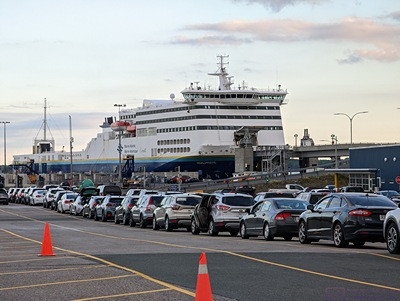
Passenger vehicles lined up to board the MV Highlanders ferry from North Sydney, NS to Channel-Port-aux-Basques, NL.
As we pulled in past the gate, it became obvious that there were many lanes for queueing up vehicles, and Lane 12 was the recreational vehicle lane. A lot of vehicles were already in line, with all of the passenger vehicles in multiple lanes to our right, and all of the tractor-trailers and other commercial trucks in multiple lanes to our left.
One of the first things we noticed was how many people were out of their vehicles. Many were chatting with their temporary neighbors or traveling companions, others were walking dogs, and some were having dinner. One guy had set up dinner for his family on the roof of their Jeep pick-up. It was all surprisingly relaxed and friendly and we got out of the truck and did the same. In fact, we moved Juniper back into the trailer so she had access to food, water, and her litter tray. A man stopped to chat with us, initially drawn by our Airstream Flying Cloud travel trailer. He was from Newfoundland, and we enjoyed our conversation with this “islander.”
We did not need to use the terminal for check-in, but realized that the person at the entrance gate did not give us the “Pet Onboard” placard for our windshield. We went inside to see if we could take care of that without having to walk back to the main entrance gate. Sure enough, the terminal is where walk-on passengers check-in and the agent gave us the placard. The terminal was very nice, and I got a picture of the vehicle staging area from the second-floor observation deck.
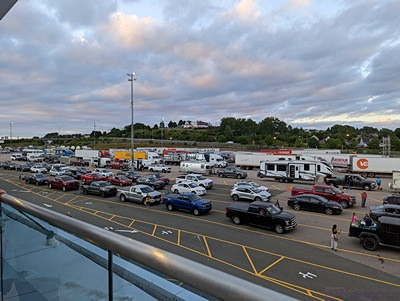
A view of the vehicle staging area from the 2nd floor observation lounge of the Marine Atlantic Ferry Terminal, North Sydney, NS.
One of the things I was still unclear about was the tagging of our propane tanks. I knew I had to shut them off, and I knew I had to “tag” them, but I wasn’t sure where to put the tags. A MA employee eventually came around verifying that we had boarding passes and checking our IDs. I explained that our propane tanks were under a cover, but he was not concerned about it. He said I could put the tags on the tanks themselves (preferred) but anywhere nearby was fine. If anyone wanted to check, they would open the lid on the cover. I had to sign his log. Linda went ahead and moved our remaining perishable items to the Styrofoam cooler and turned off the refrigerator. I then closed the valves on both propane tanks and attached the tags directly to the handles at the top.
By not arriving at the last minute, we knew we would be waiting quite a while but the time passed quickly enough, up to a point. That point was when 9:15 PM came and went and we still had not seen any vehicles board the ship. In fact, from our vantage point we couldn’t really tell just how vehicles would get on. Eventually we saw a tractor-trailer climb up an access ramp that curved around to (what turned out to be) the bow of the ship and enter through a large hatch, the door of which appeared to be the loading ramp. And then nothing else moved for what seemed like a long time. And then another semi, and then nothing.
As the daylight started to fade, the sociable atmosphere continued. Clearly many (most) of these people had done this before, knew what to expect and when to expect it. From the information we had received from Marine Atlantic, we knew there would be a PA announcement when we needed to return to our vehicles. Indeed, the PA system was pretty good, and I could understand all of the announcements clearly. The call to return to our vehicles came over the PA system at 9:20 PM, but we were already there.
The vessel we would be boarding was the MV Highlanders. Here is some information about it from the Marine Atlantic website, Onboard Experience page:
“The MV Highlanders is named in recognition of the distinguished military service of the Highlander infantry regiments throughout Nova Scotia (now known as the Nova Scotia Highlanders and the Cape Breton Highlanders). These men and women continue to provide humanitarian assistance and peacekeeping services recognized throughout the world.”
And here’s the link to the technical information about the ship:
https://www.marineatlantic.ca/onboard-experience/our-fleet/mv-highlanders
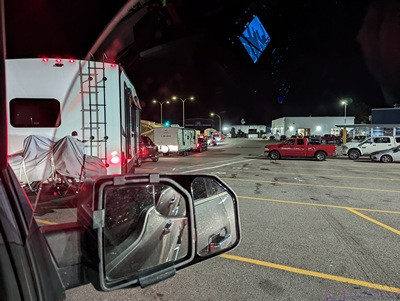
The RV lane was the last to load, but we were finally moving. We did not use the ramp that many of the large trucks used. (Photo by Linda.)
Eventually more semi’s made their slow roll to the ship and the lines of cars started to move as well. That’s when we noticed that the cars were not going up the ramp like the trucks, but rather around and then underneath it to a lower deck loading ramp. We also figured out that the RVs would be the last lane loaded and finally got to be part of the conga line into the ship.
PHOTO – 400×301 MA RV loading at lower level D3 through bow ramp (Linda)
We watched the RVs ahead of us, because what else were we going to do. Eventually the motorhome just ahead of us pulled into the ship and then it was finally out turn to board. It was 10:30 PM.
The bay opening wasn’t generous, but it was wide enough, and the approach provided plenty of distance to get the trailer straight behind the truck before entering. We had noticed quite a few MA employees out in the staging area in high visibility yellow and orange security vests and hard hats, initially checking in on vehicles and then eventually directing them when to start their engines and move forward. The same was true for the ship boarding process; lots of MA employees in security vests and hard hats orchestrating the onboarding and placement of each vehicle.
Once we were inside the ship we could finally see how it was being loaded. Cars and motorcycles, being small and lighter, were lined up in multiple lanes along the hull and larger/heavier vehicles, including all of the RVs, where being pulled into the center. Everything was nose-to-tail with just enough room to walk between vehicles. The motorcycles were all strapped down to attachment points on the floor.
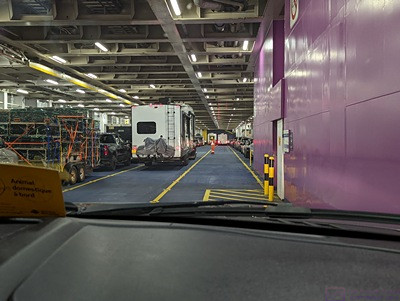
That’s our parking spot, straight ahead and way up there. The purple structure on the right contains the elevator(s). (Photo by Linda.)
I was directed to move one lane to our right and could finally see where we would be parked, almost at the rear of the ship. This is also when we realized we would not be off-boarding the way we on-boarded, as we would all be driving out the stern. Pets had to stay in the RVs unless staying in the onboard kennel or in a pet-friendly cabin. Passengers are NOT allowed in the vehicle decks when the ship is underway. We had to move Juniper from the truck to the trailer for the passage. We felt a bit pressured to get this done quickly, but a MA employee told us we had time.
The PA system told us we were on Deck 3 (purple) and to remember the location of our vehicle on the deck. We were then directed to go to the elevator tower, which we passed shortly after entering the ship. Our cabin was on Deck 8, and would have gladly walked up but there did not appear to be a stairwell.
We had booked a 2-berth outside (window) cabin. All of the cabins were on Deck 8 so we exited the elevator there and found our cabin (8115). The cabin was very nice, but our main reason for having it was so we could (try to) sleep on the overnight passage. While a daytime passage might have been more scenic, it did not work well for check-out and check-in times at RV parks. The upside of a nighttime passage was the possibility of seeing a really dark night sky. It had been a long day, but we left our suitcase there and went for a stroll to check out some of the ship.
We learned that all of the vehicles were on Decks 1, 3, and 5. (My presumption is that this was really Decks 1-2, 3-4, and 5-6, the even number decks missing from the cargo holds to allow for the height of trucks and RVs.) All of the passenger amenities were on Decks 7, 8, and 9, with Deck 10 being the bridge and heliport (forward) and roof deck (aft).
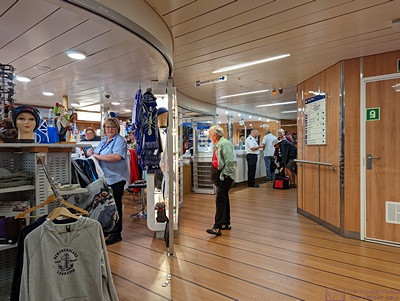
The ferry really was a mini cruise ship in some respects. This is Deck 7 mid-ships. Gift shop, reception area. Cafe / snack bar aft, bar and buffet forward. Access to outside decks.
The passenger decks looked a felt a bit like a mini-cruise ship. Deck 7 had a Reception (customer service) area and a gift shop mid-ships. There was a stairwell near the elevators and just aft of that was a snack and coffee bar. Everything else aft was seating. The bow end of the deck had a bar and just aft of that a buffet. The buffet was closed but would be serving breakfast early. The bar was open and busy. (Perhaps, like flying, some people have anxiety about an ocean crossing, even a short one.) There was more seating up this way as well. The seats were large and looked to be comfortable. Good thing, as most passengers were going to sleep in them during the passage. There was also access to outside areas on both sides where the lifeboats were stored.
All of the cabins were forward on Deck 8, with more seating aft. Deck 9 was all reserved seating. Apparently, the seating on Decks 7 and 8 was first come, first served. Not so on Deck 9, which was restricted access, so we didn’t get to see it. A stairwell provided access to the aft roof section of Deck 10 from Decks 7 and 8 so we went up there to enjoy the brisk night air and watch the ship leave port.
Scheduled departure was at 23:15 but the ship started backing out closer to 23:30. The ship was large and heavy, but moved slowly and smoothly. Once it was clear of the pier the combination of rudders and bow thrusters allowed it to turn around its center point until the bow was pointed in the required direction. As midnight approached, we went back down to Deck 7. We got a couple of cups of decaf coffee and took them back to our cabin to enjoy before turning in for the night.
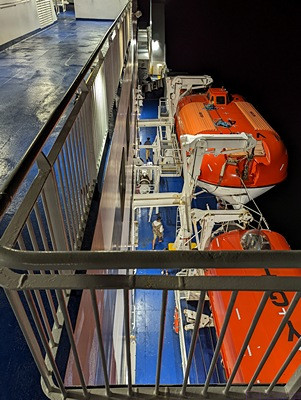
View of the port side of the ship, looking aft from Deck 10 (the roof). The same kind of lifeboats used on cruise ships.
Seas were calm for the entire passage and we were barely aware of any movement of the ship. We had a starboard side window cabin, and were traveling north, so I was aware of the first glow of morning. We had both set alarms before going to sleep for 45 minutes before our scheduled arrival time at the Marine Atlantic terminal in Channel-Port-aux-Basques, Newfoundland. The “45-minutes to arrival” announcement came over the PA system and our alarms went of a few minutes later. The sun had already risen and the ship was sounding its fog horn. A glance out the window revealed heavy, patchy fog. We got dressed, repacked our little suitcase, and waited for the announcement telling us to return to our vehicles. I continued to watch out the window and suddenly, there it was; our first sight of Newfoundland!
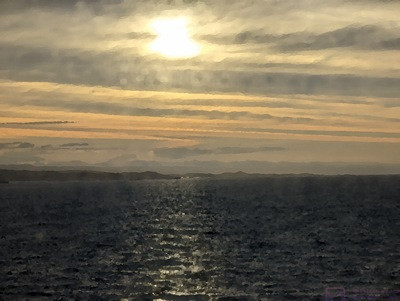
Land ho! Our first view of Newfoundland a little after sunrise. (Oil painting special effect applied as this was shot through a window.)
It took the full 45 minutes to go the relatively short distance into the harbor, turn the ship around, and dock it stern to so that all of the vehicles could exit. Because we were near the front of the line, we suspected that we might be one of the first rigs off the boat. We made our way to the elevators ahead of the return to vehicles announcement and waited. We were able to get on an elevator fairly quickly and make out way to our rig. We got Juniper back into the truck and were barely settled in ourselves when the RV in front of us pulled forward. The Marine Atlantic crew member signaled for me to hold my position, and then motioned for me to go. And just like that, we were in Newfoundland, almost 7 hours to the minute from when we left the North Sydney pier. Well, technically, we had crossed the “border” between Nova Scotia and Newfoundland & Labrador about mid-way between the two terminals. At some point my phone updated to the Newfoundland time zone and advanced the time by 30 minutes, so we hit Newfoundland at 8 AM by the clock. Check-in at the Gros Morne – Norris Point KOA, 344 km (~ 214 miles) away was 1 PM. Our estimated travel time was 3 hrs. 45 mins.
…
